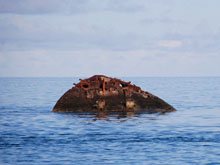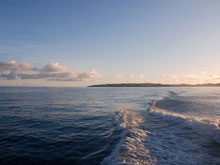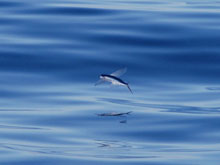The wake of the research vessel (R/V) Endurance as it leaves the harbor in the early morning. Click image for larger view and image credit.
The View Behind the Cameras
September 24, 2009
Emily McDonald
Web Coordinator
NOAA Office of Ocean Exploration and Research
The alarm goes off at 5:45. After a quick breakfast, I’m out the door in the pre-dawn darkness, loaded down with cameras, sunscreen, and Dramamine. I meet the other expedition team members and we catch the first bus out of St. George down to the Bermuda Aquarium, where our 45-foot research vessel, the R/V Endurance is docked. The expedition team is here to gather data using a remotely operated vehicle (ROV) to search for caves in the deep waters off the Bermuda shelf. I’m here to bring the expedition to life for the general public through pictures, video, and words.
The R/V Endurance is not at the dock so we have to climb down a seawall and into a tiny dinghy to ferry across to the vessel. My strength and balance are both put to the test as I lower myself down, and then once at the boat, I have to heave myself (and my bag of camera equipment) up and over the side of the Endurance. I’ve quickly learned that when you head out into the field to document science, you can’t be timid and you have to be prepared — for just about anything.
All personnel and equipment securely on board, we slowly motor out of the harbor and head for the open ocean. The potential caves are located outside of Bermuda’s protective barrier reef, giving us anywhere from one to two hours of transit time to get to the day’s dive locations. This gives us the opportunity to prepare for the day's operations, as well as to learn more about our surroundings.

The wreck of the HMS Vixen, which was purposely sunk during World War II to block the channel into Hamilton from German U-boats. Click image for larger view and image credit.
We pass the wreck of the HMS Vixen, a ship purposely sunk during World War II to block the channel into Hamilton from German U-boats. Heading further out into the ocean, we pass by North Rock, the farthest out piece of "land" on Bermuda. North Rock marks the end of the reef. Used by British troops for target practice during World War II, the rock has been hit so many times there is little of it left, but it is still guarded by a light to warn sailors of the shallows.
Outside the reef, the brilliant blue open ocean surrounds us and swells rock our little boat gently. Flying fish skim the waves, gliding between troughs like tiny humming birds. All the while, I’m bouncing from one end of the boat to the other, juggling both a still and video camera, so as not to miss a second of the action and stay out of the way of the scientific operations.
Flying fish are a common sight in the waters just outside Bermuda’s protective reef. Click image for larger view and image credit.
The ever-rocking ship turns my typically legible handwriting to chicken scratch as I jot down notes about the day’s activities. It takes every ounce of strength for me to keep my balance as I photograph and film. Filming the sea anchor launch today required nerves of steel, strength, and balance as I sat atop the bow, clinging to a line with one hand, camera in the other. The seas pitched the boat, but I held and got the shot — and that’s what matters.
There are lots of ups, downs, rolls, and pitches when it comes to coordinating the Web reports and multi-media for any expedition, and this one is no exception. But my day has been amazing, filming and photographing exciting research in a unique location, so I’ll smile and take it all in stride. Nothing good comes easy!
Sign up for the Ocean Explorer E-mail Update List.















